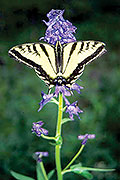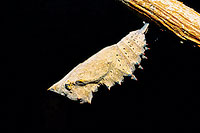 A great summer pastime is to visit a field of wildflowers either high up in the mountains or scattered along some canyon bottom and watch for the “flying jewels” of the summer sky - butterflies.
A great summer pastime is to visit a field of wildflowers either high up in the mountains or scattered along some canyon bottom and watch for the “flying jewels” of the summer sky - butterflies.
Maybe you’ve wondered about the origin of the name “butterfly” for these colorful members of the Lepidopteran. Though there are butter-colored butterflies that may have inspired this name, there are other, better possibilities. An Old Dutch word boterschijte literally translates to the yellow color of a butterfly’s first poop (meconium) after the larvae emerges from its chrysalis. Other origins have to do with the old belief that butterflies fed on butter or milk, perhaps as discarded leftovers in a European farm setting. Botterlicker (butter-licker) and milchdieb (milk-thief) are a couple of Old German names for these insects. Something to ponder while you wander through the fields of flowers.
Most butterflies feed on flower nectar (some feed on tree sap) and various species supplement their diets with salts and minerals derived from moist soil, rotting fruit, feces, human sweat, or even from dead animals. So don’t be surprised to see a kaleidoscope (group) of butterflies “puddling” – standing around a puddle or moist ground and sucking up some nutrients.
Here are a few of these summer “flutterbys” that one might encounter.
Mourning cloak butterfly. Named for the dark wings that resembled a cloak worn by someone in mourning, these butterflies feed on sap from deciduous trees such as willow and cottonwood, and are one of the first butterflies to appear in spring. After the larvae have gone through their metamorphosis and spent the season flitting about, the adults may overwinter hidden behind loose bark or old boards.
Painted ladies. Some years, painted lady butterflies migrate into southern Utah by the millions. By July, they may be a little more difficult to locate but check out summertime thistle plants for signs of the larvae. The spiny leaves may protect the plants against herbivores but not against hungry caterpillars. The next generation of adult butterflies will migrate back south into Mexico and the southwestern U.S. to overwinter.
Monarchs. This butterfly royalty receives a lot of attention for their spectacular migration and relationship to milkweed as host plants for the larvae. As the caterpillars feed on the milkweed leaves, they ingest toxins that make them unpalatable to predators. The adult’s orange wings with black veins resemble stained glass artwork, and a close relative – the viceroy – mimics this appearance to also appear unpalatable, thus avoiding predation. 
Tiger swallowtails. These are large beautiful butterflies which flit and float across summer meadows searching for nectar and a place to lay their eggs.
Fritillaries. There are several species of fritillary butterflies that one may encounter on a summer hike. The wings have shades of orange and black arranged in a checkerboard pattern; get a good photograph of one to aid in identification.
The Blues. Like the fritillaries, there are several species of blues that might be found on a hike. Their stark blue color enables them to stand out in a field of wildflowers or set against dark green foliage of a pine or spruce tree. When the wings are folded upwards, the butterflies are grayish but when the wings are held flat, the reason behind their name becomes evident.
If you’re interested in identifying summer butterflies, it’s a good idea to get several close-up photographs showing both the undersides and topsides of the butterfly. Try not to handle them as it’s easy to damage their fragile wings. To aid in identification, there are numerous field guides or Internet sites such as iNaturalist or Butterflies and Moths of Southeast Utah on Facebook. Enjoy! `